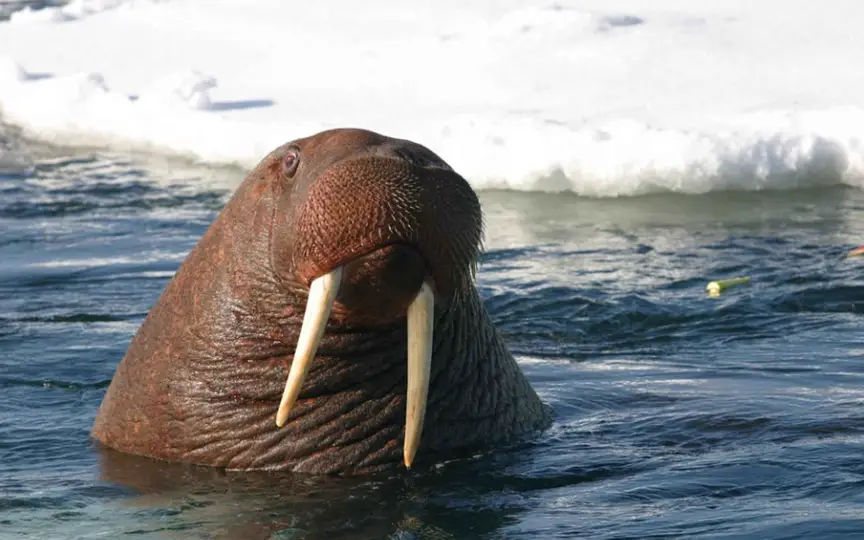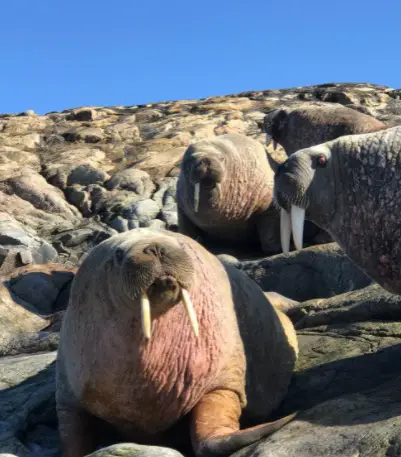Table of Contents
Walrus: All You Need To Know
The walrus is a large marine mammal that belongs to the kingdom of Animalia, phylum Chordata, and class Mammalia. Its genus is Odobenus and its species is Odobenus rosmarus. Its length is 2 to 3.5 m and it weighs up to 800 to 1200 kg. It lives in the cold waters of the Arctic with a lifespan up to 40 years in the wild.

What is Walrus?
The Walrus (Odobenus rosmarus) is a huge marine mammal that lives in the Arctic seas. The Atlantic walrus (O. rosmarus rosmarus) and the Pacific walrus (O. rosmarus divergens) are two subspecies that live in separate parts of the Arctic. While there isn’t enough evidence to correctly forecast their condition, it’s estimated that there are 25,000 Atlantic and 200,000 Pacific walruses surviving in the wild.

Walruses are pinnipeds, a clade of fin-footed, semi-aquatic mammals that includes seals and sea lions and is found all over the world. Walruses may grow to be 12 feet (3.7 metres) long and weigh up to 3,700 pounds (1,700 kg).
These creatures have sexual dimorphism in their size, with males typically being a third bigger than females. Walruses have a spherical head with tiny eyes and no ears on the outside. They also have a short, wide snout with vibrissae, which are quill-like whiskers. Their grey skin is robust and can be as thick as 1-2 inches (2-4 cm).
The walruses’ coats are coated with short, reddish hair, giving them a warm brown hue. The tusks of walruses are huge! These large, upper canine teeth may reach a length of 3.2 feet (one metre) and weigh up to 12 pounds (5.4 kilogrammes).
Tusks are present in both sexes, although males’ tusks are generally much bigger, and they are used in mating displays and defence against other walruses. Clams and mussels make up the majority of the walrus’ diet, with clams being their favourite!
They make a seal by placing their lips over the clam’s shell when they find it. They then swiftly move their tongues to the rear of their mouth to create a vacuum. This allows them to extract the flesh from the shell. Walruses consume a variety of fish, crabs, and tiny marine creatures, among other things.
When seals and even narwhals are caught by the ice, they have been known to hunt them. Walruses root around the ocean floor at modest depths, generally between 30 and 160 feet (10 and 50 metres). They utilise their whiskers to identify prey.

Walrus Can be Social
Walruses live in herds that are generally divided according to gender. They may be found in large numbers on ice floes and on land, where they dwell in groups of hundreds of animals. During mating season, this number can reach tens of thousands. Male walruses will battle to dominate a harem of females when mating season begins.
Males mate with a large number of females, whereas females only mate with one male. Females typically give birth between April and June after a 15-month gestation period. Walrus calves may weigh up to 75 kilogrammes (165 pounds).
The calves are able to swim right away. The moms milk their calves for almost a year, and the calves can spend up to five years with their mothers. Walruses, like dogs, run on all fours and can move remarkably rapidly on land. Their pace is comparable to that of a human sprinter.
Unfortunately, walruses are prone to being startled, which can result in a stampede. When walruses congregate in huge groups, it is possible for individuals of the herd to be crushed to death. The greatest threat to walruses now is climate change. Melting sea ice has an impact on people in both the Arctic and the Pacific, but in different ways.
More shipping, tourists, and industry are causing more noise and raising the likelihood of stampedes, putting Arctic walruses at jeopardy. Melting sea ice is pushing more Pacific walruses to come ashore. Not only is this further away from their feeding areas, but it also means that there are more walruses in one place.
These huge groupings put certain walruses, especially young calves, at risk of death from stampedes since these animals are easily startled. Polar bears, killer whales, and people all hunt walruses.
Fun Facts About Walrus!
The walrus is a huge marine animal known for its long, ivory tusks and moustache. This pinniped may be found across the Arctic’s frigid seas, and it has a number of biological adaptations that help it survive.
Walrus populations, which were formerly overhunted for their skin and tusks, are now partly protected, although precise information on their population numbers is lacking. Let’s take a closer look at this amazing creature!
Walrus: a Blubber
Walruses live in some of the most inhospitable environments on the planet. They spend the most of their time in frigid water, losing heat 27 times quicker than on land. Despite this, the walrus keeps its body warm and its metabolism is unaffected by the cold. Walruses have excellent insulation in the form of blubber, a coating of fat.
The walrus’s blubber, which is situated just beneath the skin, keeps them warm while also helping to streamline their bodies and providing them with energy when they need it most. In the winter, this layer of fat may be up to 3.9 inches (10cm) thick and constitute up to one-third of the walrus’s weight! Several marine mammals have developed blubber as a protective adaptation to help them deal with their chilly surroundings.
Icelandic Walrus
Icelandic Walruses were targeted for their skins and tusks, which were valuable commodities. Their ivory tusks were highly sought after. While they are currently hunted in small quantities in the United States, Canada, Greenland, and Russia, they were formerly commercially hunted, which had a significant influence on their population.
Scientists have discovered that a unique type of walrus used to live in Iceland before going extinct in about 1100. These walrus populations were originally considered to be part of larger populations located farther north, but researchers were able to determine that they belonged to a distinct subspecies by analysing mitochondrial DNA from walrus bones.
According to research, people are to blame for the extinction of this mammal, and it is one of the first instances of humans wreaking havoc on marine life. The walrus hide would have been utilised for clothes and rope on the settlers’ boats by the Icelandic settlers.
Walrus oil was used to offer insulation as well as deter crustaceans from causing damage to the ships’ hulls. Their tusks were also used to make calvings, which were frequently given to monarchs.
No External Ears
Unlike other animals, walruses do not have external ear flaps; instead, their ears are two tiny holes with protective flaps. The lack of external ears is an adaptation to the cold since it minimises the number of external appendages and the amount of skin exposed to heat loss. The ears of a walrus are often hidden by their skin folds, making them difficult to see.
In the water, their hearing works the same way as it does on land. The walrus ear possesses exceptional morphological characteristics that set it apart from other mammalian ear structures. The outer ear of a walrus is fully encased in fat and protected by thick skin.
The middle ear cavity is also rather big, with vascularized tissue, elastic fibres, and collagen tissue lining it. Dense bones surround the base of the outer ear, as well as the whole middle and inner ear. A walrus’ hearing is exceptional, and it can perceive sounds from up to a mile away (1.6 km).
Walrus Citations
- Vocal learning in seals, sea lions, and walruses. Curr Opin Neurobiol . 2014 Oct;28:66-71.
- Limitations of an optimum sustainable population or potential biological removal approach for conserving marine mammals: Pacific walrus case study. J Environ Manage . 2009 Oct;91(1):57-66.
- Atlantic walrus signal latitudinal differences in the long-term decline of sea ice-derived carbon to benthic fauna in the Canadian Arctic. Proc Biol Sci . 2020 Dec 9;287(1940):20202126.
- Seal gut and walrus ivory. Br Dent J . 2019 Nov;227(9):761.







